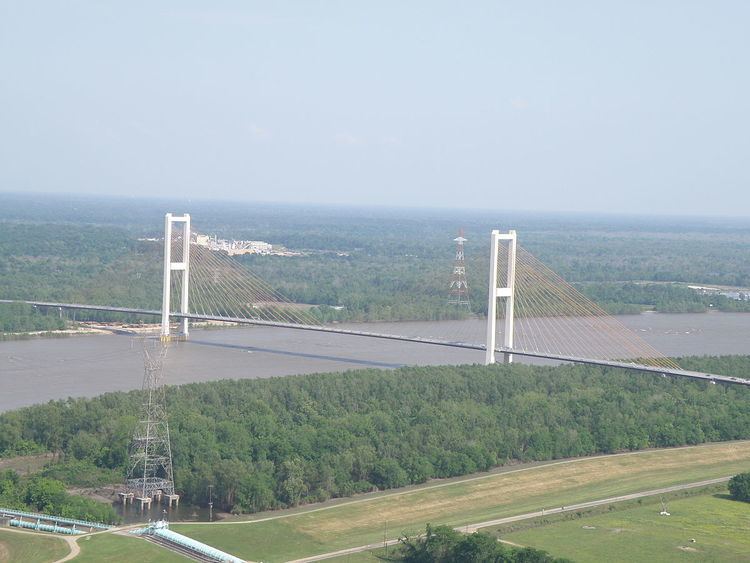Carries 4 lanes of LA 10 Maintained by LaDOTD Width 75.8 ft (23.1 m) Construction started 11 May 2006 Total length 3,927 m | Opened 5 May 2011 Height 152 m Body of water Mississippi River | |
 | ||
Address LA-10, Ventress, LA 70783, USA Similar Hale Boggs Memorial, Huey P Long Bridge, Sunshine Bridge, Gramercy Bridge, Greenville Bridge | ||
The John James Audubon Bridge, completed and opened in 2011, is a Mississippi River crossing between Pointe Coupee and West Feliciana parishes in south central Louisiana. The bridge has the second longest cable-stayed span (distance between towers) in the Western Hemisphere at 1,583 ft (482 m), after Mexico's Baluarte Bridge with a 1,706 ft (520 m) span, and has a total length of 12,883 ft (3,927 m)—nearly three-and-a-half times longer than the Baluarte Bridge's 3,688 ft (1,124 m) total length. The Audubon Bridge replaces the ferry between the communities of New Roads and St. Francisville. The bridge also serves as the only bridge structure on the Mississippi River between Natchez, Mississippi and Baton Rouge, Louisiana (approximately 90 river miles). The bridge conveys Louisiana Highway 10, which is in a concurrence there with the Zachary Taylor Parkway.
The Audubon Bridge corridor includes:
The bridge became officially connected across the Mississippi River on Wednesday, December 29, 2010. Completion for public use was not expected until June 2011; however, the bridge was opened on May 5, 2011 due to rising water levels on the Mississippi River, which had forced the closure of the ferry connection. The bridge is equipped with special finger type sliding joints in order to accommodate large movements between the decks. The 24-ton joints were designed by mageba, an international civil engineering firm, and allow a movement of 49 in (1.24 m).
The project was constructed by Audubon Bridge Constructors, a joint venture of Flatiron Construction, Granite Construction and Parsons Transportation Group. The construction manager was Louisiana TIMED Managers, a joint venture of GEC, Inc., PB Americas, Inc., and LPA Group Incorporated. Upon completion, ownership of the bridge was turned over to the Louisiana Department of Transportation and Development.
As a gateway, it is intended to provide highway traffic where centuries of ferry crossings and longer commutes have been the norm.
Artist John James Audubon dedicated his life to painting all of the birds in North America. He painted 32 of his famous works in his Birds of America series while residing at Oakley Plantation at St. Francisville as a tutor to Eliza Pirrie in 1821. Naming the new bridge after Audubon is significant to the project because it exemplifies the importance and preservation of the rich natural history of the region.
In 2011, House Bill 200 was proposed in the Louisiana Legislature to rename the bridge the "Generals John A. Lejeune-Robert H. Barrow Bridge." Proponents of the measure argued that Audubon only spent a comparatively small amount of time in Louisiana and that there already existed twin bridges named after him spanning the Ohio River (those bridges have since been renamed the Bi-State Vietnam Gold Star Bridges). Additionally, they stated that Generals John A. Lejeune, originally from Pointe Coupee Parish, and Robert H. Barrow, originally from West Feliciana Parish, who both served as Commandant of the United States Marine Corps were more worthy of the honor. A compromise was reached and the bill was signed into law as Act No. 227, effective August 15, 2011. Per the signed final version of the law, although the bridge still retains Audubon's name, the east approach to the bridge has been named the "General Robert H. Barrow Memorial Approach" and the west approach has been named the "General John A. Lejeune Memorial Approach."
